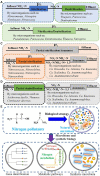Advances in Studies on Microbiota Involved in Nitrogen Removal Processes and Their Applications in Wastewater Treatment
- PMID: 34733260
- PMCID: PMC8560000
- DOI: 10.3389/fmicb.2021.746293
Advances in Studies on Microbiota Involved in Nitrogen Removal Processes and Their Applications in Wastewater Treatment
Abstract
The discharge of excess nitrogenous pollutants in rivers or other water bodies often leads to serious ecological problems and results in the collapse of aquatic ecosystems. Nitrogenous pollutants are often derived from the inefficient treatment of industrial wastewater. The biological treatment of industrial wastewater for the removal of nitrogen pollution is a green and efficient strategy. In the initial stage of the nitrogen removal process, the nitrogenous pollutants are converted to ammonia. Traditionally, nitrification and denitrification processes have been used for nitrogen removal in industrial wastewater; while currently, more efficient processes, such as simultaneous nitrification-denitrification, partial nitrification-anammox, and partial denitrification-anammox processes, are used. The microorganisms participating in nitrogen pollutant removal processes are diverse, but information about them is limited. In this review, we summarize the microbiota participating in nitrogen removal processes, their pathways, and associated functional genes. We have also discussed the design of efficient industrial wastewater treatment processes for the removal of nitrogenous pollutants and the application of microbiome engineering technology and synthetic biology strategies in the modulation of the nitrogen removal process. This review thus provides insights that would help in improving the efficiency of nitrogen pollutant removal from industrial wastewater.
Keywords: anammox; denitrifying bacteria; microbiome; nitrifying bacteria; nitrogen pollution removal; wastewater.
Copyright © 2021 Mai, Chen, Liu, Liang, Tang and Wei.
Figures

Similar articles
-
Biological removal of nitrogen from wastewater.Rev Environ Contam Toxicol. 2008;192:159-95. doi: 10.1007/978-0-387-71724-1_5. Rev Environ Contam Toxicol. 2008. PMID: 18020306 Review.
-
[Advances in denitrification microorganisms and processes].Sheng Wu Gong Cheng Xue Bao. 2021 Oct 25;37(10):3505-3519. doi: 10.13345/j.cjb.210407. Sheng Wu Gong Cheng Xue Bao. 2021. PMID: 34708607 Review. Chinese.
-
A review of microbial nitrogen transformations and microbiome engineering for biological nitrogen removal under salinity stress.Chemosphere. 2023 Nov;341:139949. doi: 10.1016/j.chemosphere.2023.139949. Epub 2023 Aug 28. Chemosphere. 2023. PMID: 37648161 Review.
-
[Denitrification Process and N2O Production Characteristics of Heterotrophic Nitrifying Bacterium Pseudomonas aeruginosa YL].Huan Jing Ke Xue. 2020 Feb 8;41(2):831-838. doi: 10.13227/j.hjkx.201908223. Huan Jing Ke Xue. 2020. PMID: 32608744 Chinese.
-
Analysis of enhanced nitrogen removal mechanisms in a validation wastewater treatment plant containing anammox bacteria.Appl Microbiol Biotechnol. 2019 Feb;103(3):1255-1265. doi: 10.1007/s00253-018-9495-2. Epub 2018 Dec 11. Appl Microbiol Biotechnol. 2019. PMID: 30539255
Cited by
-
Microbiota composition and correlations with environmental factors in grass carp (Ctenopharyngodon idella) culture ponds in South China.PeerJ. 2023 Oct 12;11:e15892. doi: 10.7717/peerj.15892. eCollection 2023. PeerJ. 2023. PMID: 37846307 Free PMC article.
-
Selection, Identification and Functional Performance of Ammonia-Degrading Microbial Communities from an Activated Sludge for Landfill Leachate Treatment.Microorganisms. 2023 Jan 25;11(2):311. doi: 10.3390/microorganisms11020311. Microorganisms. 2023. PMID: 36838276 Free PMC article.
-
Dynamic Response Mechanisms of Anammox Reactors Under Nitrogen-Loading Fluctuations: Nitrogen Removal Performance, Microbial Community Succession, and Metabolic Functions.Microorganisms. 2025 Apr 14;13(4):899. doi: 10.3390/microorganisms13040899. Microorganisms. 2025. PMID: 40284735 Free PMC article.
-
Development and Characterization of Ammonia Removal Moving Bed Biofilms for Landfill Leachate Treatment.Microorganisms. 2024 Nov 23;12(12):2404. doi: 10.3390/microorganisms12122404. Microorganisms. 2024. PMID: 39770607 Free PMC article.
-
Achieving Partial Nitrification-Anammox Process Dependent on Microalgal-Bacterial Consortia in a Photosequencing Batch Reactor.Front Bioeng Biotechnol. 2022 Mar 18;10:851800. doi: 10.3389/fbioe.2022.851800. eCollection 2022. Front Bioeng Biotechnol. 2022. PMID: 35372325 Free PMC article.
References
-
- Cai J., Jiang J., Zheng P. (2010). Isolation and identification of bacteria responsible for simultaneous anaerobic ammonium and sulfate removal. Sci. China Chem. 53, 645–650. doi: 10.1007/s11426-010-0053-8 - DOI
-
- Carneiro Fidélis Silva L., Santiago Lima H., Antônio de Oliveira Mendes T., Sartoratto A., de Paula Sousa M., Suhett de Souza R., et al. . (2019). Heterotrophic nitrifying/aerobic denitrifying bacteria: ammonium removal under different physical-chemical conditions and molecular characterization. J. Environ. Manag. 248:109294. doi: 10.1016/j.jenvman.2019.109294, PMID: - DOI - PubMed
Publication types
LinkOut - more resources
Full Text Sources

